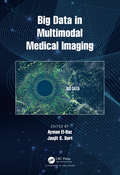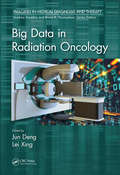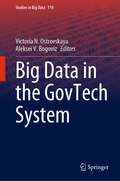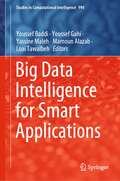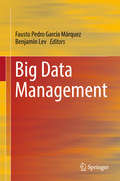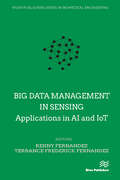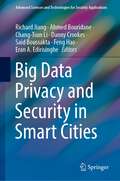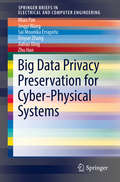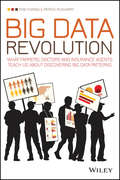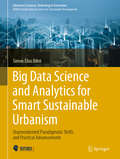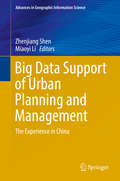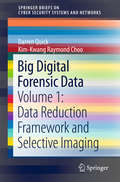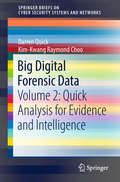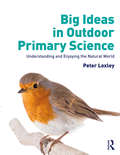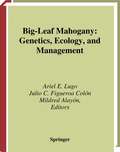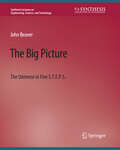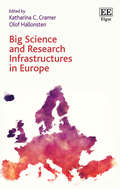- Table View
- List View
Big Data in Multimodal Medical Imaging
by Ayman El-Baz Jasjit S. SuriThere is an urgent need to develop and integrate new statistical, mathematical, visualization, and computational models with the ability to analyze Big Data in order to retrieve useful information to aid clinicians in accurately diagnosing and treating patients. The main focus of this book is to review and summarize state-of-the-art big data and deep learning approaches to analyze and integrate multiple data types for the creation of a decision matrix to aid clinicians in the early diagnosis and identification of high risk patients for human diseases and disorders. Leading researchers will contribute original research book chapters analyzing efforts to solve these important problems.
Big Data in Multimodal Medical Imaging
by Jasjit S. Suri Ayman El-BazThere is an urgent need to develop and integrate new statistical, mathematical, visualization, and computational models with the ability to analyze Big Data in order to retrieve useful information to aid clinicians in accurately diagnosing and treating patients. The main focus of this book is to review and summarize state-of-the-art big data and deep learning approaches to analyze and integrate multiple data types for the creation of a decision matrix to aid clinicians in the early diagnosis and identification of high risk patients for human diseases and disorders. Leading researchers will contribute original research book chapters analyzing efforts to solve these important problems.
Big Data in Radiation Oncology (Imaging in Medical Diagnosis and Therapy)
by Jun Deng Lei XingBig Data in Radiation Oncology gives readers an in-depth look into how big data is having an impact on the clinical care of cancer patients. While basic principles and key analytical and processing techniques are introduced in the early chapters, the rest of the book turns to clinical applications, in particular for cancer registries, informatics, radiomics, radiogenomics, patient safety and quality of care, patient-reported outcomes, comparative effectiveness, treatment planning, and clinical decision-making. More features of the book are: Offers the first focused treatment of the role of big data in the clinic and its impact on radiation therapy. Covers applications in cancer registry, radiomics, patient safety, quality of care, treatment planning, decision making, and other key areas. Discusses the fundamental principles and techniques for processing and analysis of big data. Address the use of big data in cancer prevention, detection, prognosis, and management. Provides practical guidance on implementation for clinicians and other stakeholders. Dr. Jun Deng is a professor at the Department of Therapeutic Radiology of Yale University School of Medicine and an ABR board certified medical physicist at Yale-New Haven Hospital. He has received numerous honors and awards such as Fellow of Institute of Physics in 2004, AAPM Medical Physics Travel Grant in 2008, ASTRO IGRT Symposium Travel Grant in 2009, AAPM-IPEM Medical Physics Travel Grant in 2011, and Fellow of AAPM in 2013. Lei Xing, Ph.D., is the Jacob Haimson Professor of Medical Physics and Director of Medical Physics Division of Radiation Oncology Department at Stanford University. His research has been focused on inverse treatment planning, tomographic image reconstruction, CT, optical and PET imaging instrumentations, image guided interventions, nanomedicine, and applications of molecular imaging in radiation oncology. Dr. Xing is on the editorial boards of a number of journals in radiation physics and medical imaging, and is recipient of numerous awards, including the American Cancer Society Research Scholar Award, The Whitaker Foundation Grant Award, and a Max Planck Institute Fellowship.
Big Data in Radiation Oncology (Imaging in Medical Diagnosis and Therapy)
by Jun Deng and Lei XingBig Data in Radiation Oncology gives readers an in-depth look into how big data is having an impact on the clinical care of cancer patients. While basic principles and key analytical and processing techniques are introduced in the early chapters, the rest of the book turns to clinical applications, in particular for cancer registries, informatics, radiomics, radiogenomics, patient safety and quality of care, patient-reported outcomes, comparative effectiveness, treatment planning, and clinical decision-making. More features of the book are: Offers the first focused treatment of the role of big data in the clinic and its impact on radiation therapy. Covers applications in cancer registry, radiomics, patient safety, quality of care, treatment planning, decision making, and other key areas. Discusses the fundamental principles and techniques for processing and analysis of big data. Address the use of big data in cancer prevention, detection, prognosis, and management. Provides practical guidance on implementation for clinicians and other stakeholders. Dr. Jun Deng is a professor at the Department of Therapeutic Radiology of Yale University School of Medicine and an ABR board certified medical physicist at Yale-New Haven Hospital. He has received numerous honors and awards such as Fellow of Institute of Physics in 2004, AAPM Medical Physics Travel Grant in 2008, ASTRO IGRT Symposium Travel Grant in 2009, AAPM-IPEM Medical Physics Travel Grant in 2011, and Fellow of AAPM in 2013. Lei Xing, Ph.D., is the Jacob Haimson Professor of Medical Physics and Director of Medical Physics Division of Radiation Oncology Department at Stanford University. His research has been focused on inverse treatment planning, tomographic image reconstruction, CT, optical and PET imaging instrumentations, image guided interventions, nanomedicine, and applications of molecular imaging in radiation oncology. Dr. Xing is on the editorial boards of a number of journals in radiation physics and medical imaging, and is recipient of numerous awards, including the American Cancer Society Research Scholar Award, The Whitaker Foundation Grant Award, and a Max Planck Institute Fellowship.
Big Data in the GovTech System (Studies in Big Data #110)
by Victoria N. Ostrovskaya Aleksei V. BogovizThis book presents applications and solutions of Big Data in the GovTech system and recommendations for regulating the institutions of the digital economy and information society for the wide application of Big Data with the use of the institutional approach. In this book, a systematic scientific understanding of GovTech is formed, the central place of Big Data in this system is substantiated, and modern experience in the functioning and development of this system is considered in detail. The contribution of the book to the literature is to bridge the gap between theory and practice of GovTech through a comprehensive study of all its manifestations in the three parts of the book. The first part is devoted to GovTech in the provision of high-tech educational services based on Big Data. The second part reflects state regulation of the economy by industry using Big Data in the GovTech. The third part outlined the digital divide and the experience of overcoming it with the help of GovTech based on Big Data.The practical significance of the book lies in the fact that it offers a holistic practical guide to the development of the GovTech system based on Big Data. The book will be of interest to academic scientists studying GovTech, as it clarified its categorical apparatus and scientific basis. The subjects of management in GovTech form the secondary target audience of this book, which provides them with numerous cases from the experience of modern Russia, as well as applied recommendations for improving the efficiency of the GovTech system based on Big Data. The book is multidisciplinary and is intended for scientists from various fields of science (pedagogy, economics, business, law, management, and ICT).
Big Data Intelligence for Smart Applications (Studies in Computational Intelligence #994)
by Yassine Maleh Mamoun Alazab Youssef Baddi Loai Tawalbeh Youssef GahiToday, the use of machine intelligence, expert systems, and analytical technologies combined with Big Data is the natural evolution of both disciplines. As a result, there is a pressing need for new and innovative algorithms to help us find effective and practical solutions for smart applications such as smart cities, IoT, healthcare, and cybersecurity.This book presents the latest advances in big data intelligence for smart applications. It explores several problems and their solutions regarding computational intelligence and big data for smart applications. It also discusses new models, practical solutions,and technological advances related to developing and transforming cities through machine intelligence and big data models and techniques. This book is helpful for students and researchers as well as practitioners.
Big Data Management
by Fausto Pedro García Márquez Benjamin LevThis book focuses on the analytic principles of business practice and big data. Specifically, it provides an interface between the main disciplines of engineering/technology and the organizational and administrative aspects of management, serving as a complement to books in other disciplines such as economics, finance, marketing and risk analysis. The contributors present their areas of expertise, together with essential case studies that illustrate the successful application of engineering management theories in real-life examples.
Big data management in Sensing: Applications in AI and IoT
by Renny Fernandez Terrance Frederick FernandezThe book is centrally focused on human computer Interaction and how sensors within small and wide groups of Nano-robots employ Deep Learning for applications in industry. It covers a wide array of topics that are useful for researchers and students to gain knowledge about AI and sensors in nanobots. Furthermore, the book explores Deep Learning approaches to enhance the accuracy of AI systems applied in medical robotics for surgical techniques. Secondly, we plan to explore bio-nano-robotics, which is a field in nano-robotics, that deals with automatic intelligence handling, self-assembly and replication, information processing and programmability.
Big data management in Sensing: Applications in AI and IoT
The book is centrally focused on human computer Interaction and how sensors within small and wide groups of Nano-robots employ Deep Learning for applications in industry. It covers a wide array of topics that are useful for researchers and students to gain knowledge about AI and sensors in nanobots. Furthermore, the book explores Deep Learning approaches to enhance the accuracy of AI systems applied in medical robotics for surgical techniques. Secondly, we plan to explore bio-nano-robotics, which is a field in nano-robotics, that deals with automatic intelligence handling, self-assembly and replication, information processing and programmability.
Big Data, Open Data and Data Development
by Jean-Louis Monino Soraya SedkaouiThe world has become digital and technological advances have multiplied circuits with access to data, their processing and their diffusion. New technologies have now reached a certain maturity. Data are available to everyone, anywhere on the planet. The number of Internet users in 2014 was 2.9 billion or 41% of the world population. The need for knowledge is becoming apparent in order to understand this multitude of data. We must educate, inform and train the masses. The development of related technologies, such as the advent of the Internet, social networks, "cloud-computing" (digital factories), has increased the available volumes of data. Currently, each individual creates, consumes, uses digital information: more than 3.4 million e-mails are sent worldwide every second, or 107,000 billion annually with 14,600 e-mails per year per person, but more than 70% are spam. Billions of pieces of content are shared on social networks such as Facebook, more than 2.46 million every minute. We spend more than 4.8 hours a day on the Internet using a computer, and 2.1 hours using a mobile. Data, this new ethereal manna from heaven, is produced in real time. It comes in a continuous stream from a multitude of sources which are generally heterogeneous. This accumulation of data of all types (audio, video, files, photos, etc.) generates new activities, the aim of which is to analyze this enormous mass of information. It is then necessary to adapt and try new approaches, new methods, new knowledge and new ways of working, resulting in new properties and new challenges since SEO logic must be created and implemented. At company level, this mass of data is difficult to manage. Its interpretation is primarily a challenge. This impacts those who are there to "manipulate" the mass and requires a specific infrastructure for creation, storage, processing, analysis and recovery. The biggest challenge lies in "the valuing of data" available in quantity, diversity and access speed.
Big Data, Open Data and Data Development
by Jean-Louis Monino Soraya SedkaouiThe world has become digital and technological advances have multiplied circuits with access to data, their processing and their diffusion. New technologies have now reached a certain maturity. Data are available to everyone, anywhere on the planet. The number of Internet users in 2014 was 2.9 billion or 41% of the world population. The need for knowledge is becoming apparent in order to understand this multitude of data. We must educate, inform and train the masses. The development of related technologies, such as the advent of the Internet, social networks, "cloud-computing" (digital factories), has increased the available volumes of data. Currently, each individual creates, consumes, uses digital information: more than 3.4 million e-mails are sent worldwide every second, or 107,000 billion annually with 14,600 e-mails per year per person, but more than 70% are spam. Billions of pieces of content are shared on social networks such as Facebook, more than 2.46 million every minute. We spend more than 4.8 hours a day on the Internet using a computer, and 2.1 hours using a mobile. Data, this new ethereal manna from heaven, is produced in real time. It comes in a continuous stream from a multitude of sources which are generally heterogeneous. This accumulation of data of all types (audio, video, files, photos, etc.) generates new activities, the aim of which is to analyze this enormous mass of information. It is then necessary to adapt and try new approaches, new methods, new knowledge and new ways of working, resulting in new properties and new challenges since SEO logic must be created and implemented. At company level, this mass of data is difficult to manage. Its interpretation is primarily a challenge. This impacts those who are there to "manipulate" the mass and requires a specific infrastructure for creation, storage, processing, analysis and recovery. The biggest challenge lies in "the valuing of data" available in quantity, diversity and access speed.
Big Data Privacy and Security in Smart Cities (Advanced Sciences and Technologies for Security Applications)
by Richard Jiang Ahmed Bouridane Chang-Tsun Li Danny Crookes Said Boussakta Feng Hao Eran A. EdirisingheThis book highlights recent advances in smart cities technologies, with a focus on new technologies such as biometrics, blockchains, data encryption, data mining, machine learning, deep learning, cloud security, and mobile security. During the past five years, digital cities have been emerging as a technology reality that will come to dominate the usual life of people, in either developed or developing countries. Particularly, with big data issues from smart cities, privacy and security have been a widely concerned matter due to its relevance and sensitivity extensively present in cybersecurity, healthcare, medical service, e-commercial, e-governance, mobile banking, e-finance, digital twins, and so on. These new topics rises up with the era of smart cities and mostly associate with public sectors, which are vital to the modern life of people. This volume summarizes the recent advances in addressing the challenges on big data privacy and security in smart cities and points out the future research direction around this new challenging topic.
Big Data Privacy Preservation for Cyber-Physical Systems (SpringerBriefs in Electrical and Computer Engineering)
by Miao Pan Jingyi Wang Sai Mounika Errapotu Xinyue Zhang Jiahao Ding Zhu HanThis SpringerBrief mainly focuses on effective big data analytics for CPS, and addresses the privacy issues that arise on various CPS applications. The authors develop a series of privacy preserving data analytic and processing methodologies through data driven optimization based on applied cryptographic techniques and differential privacy in this brief. This brief also focuses on effectively integrating the data analysis and data privacy preservation techniques to provide the most desirable solutions for the state-of-the-art CPS with various application-specific requirements. Cyber-physical systems (CPS) are the “next generation of engineered systems,” that integrate computation and networking capabilities to monitor and control entities in the physical world. Multiple domains of CPS typically collect huge amounts of data and rely on it for decision making, where the data may include individual or sensitive information, for e.g., smart metering, intelligent transportation, healthcare, sensor/data aggregation, crowd sensing etc. This brief assists users working in these areas and contributes to the literature by addressing data privacy concerns during collection, computation or big data analysis in these large scale systems. Data breaches result in undesirable loss of privacy for the participants and for the entire system, therefore identifying the vulnerabilities and developing tools to mitigate such concerns is crucial to build high confidence CPS.This Springerbrief targets professors, professionals and research scientists working in Wireless Communications, Networking, Cyber-Physical Systems and Data Science. Undergraduate and graduate-level students interested in Privacy Preservation of state-of-the-art Wireless Networks and Cyber-Physical Systems will use this Springerbrief as a study guide.
Big Data Revolution: What farmers, doctors and insurance agents teach us about discovering big data patterns
by Rob Thomas Patrick McSharryExploit the power and potential of Big Data to revolutionize business outcomes Big Data Revolution is a guide to improving performance, making better decisions, and transforming business through the effective use of Big Data. In this collaborative work by an IBM Vice President of Big Data Products and an Oxford Research Fellow, this book presents inside stories that demonstrate the power and potential of Big Data within the business realm. Readers are guided through tried-and-true methodologies for getting more out of data, and using it to the utmost advantage. This book describes the major trends emerging in the field, the pitfalls and triumphs being experienced, and the many considerations surrounding Big Data, all while guiding readers toward better decision making from the perspective of a data scientist. Companies are generating data faster than ever before, and managing that data has become a major challenge. With the right strategy, Big Data can be a powerful tool for creating effective business solutions – but deep understanding is key when applying it to individual business needs. Big Data Revolution provides the insight executives need to incorporate Big Data into a better business strategy, improving outcomes with innovation and efficient use of technology. Examine the major emerging patterns in Big Data Consider the debate surrounding the ethical use of data Recognize patterns and improve personal and organizational performance Make more informed decisions with quantifiable results In an information society, it is becoming increasingly important to make sense of data in an economically viable way. It can drive new revenue streams and give companies a competitive advantage, providing a way forward for businesses navigating an increasingly complex marketplace. Big Data Revolution provides expert insight on the tool that can revolutionize industries.
Big Data Revolution: What farmers, doctors and insurance agents teach us about discovering big data patterns
by Rob Thomas Patrick McSharryExploit the power and potential of Big Data to revolutionize business outcomes Big Data Revolution is a guide to improving performance, making better decisions, and transforming business through the effective use of Big Data. In this collaborative work by an IBM Vice President of Big Data Products and an Oxford Research Fellow, this book presents inside stories that demonstrate the power and potential of Big Data within the business realm. Readers are guided through tried-and-true methodologies for getting more out of data, and using it to the utmost advantage. This book describes the major trends emerging in the field, the pitfalls and triumphs being experienced, and the many considerations surrounding Big Data, all while guiding readers toward better decision making from the perspective of a data scientist. Companies are generating data faster than ever before, and managing that data has become a major challenge. With the right strategy, Big Data can be a powerful tool for creating effective business solutions – but deep understanding is key when applying it to individual business needs. Big Data Revolution provides the insight executives need to incorporate Big Data into a better business strategy, improving outcomes with innovation and efficient use of technology. Examine the major emerging patterns in Big Data Consider the debate surrounding the ethical use of data Recognize patterns and improve personal and organizational performance Make more informed decisions with quantifiable results In an information society, it is becoming increasingly important to make sense of data in an economically viable way. It can drive new revenue streams and give companies a competitive advantage, providing a way forward for businesses navigating an increasingly complex marketplace. Big Data Revolution provides expert insight on the tool that can revolutionize industries.
Big Data Science and Analytics for Smart Sustainable Urbanism: Unprecedented Paradigmatic Shifts and Practical Advancements (Advances in Science, Technology & Innovation)
by Simon Elias BibriWe are living at the dawn of what has been termed ‘the fourth paradigm of science,’ a scientific revolution that is marked by both the emergence of big data science and analytics, and by the increasing adoption of the underlying technologies in scientific and scholarly research practices. Everything about science development or knowledge production is fundamentally changing thanks to the ever-increasing deluge of data. This is the primary fuel of the new age, which powerful computational processes or analytics algorithms are using to generate valuable knowledge for enhanced decision-making, and deep insights pertaining to a wide variety of practical uses and applications. This book addresses the complex interplay of the scientific, technological, and social dimensions of the city, and what it entails in terms of the systemic implications for smart sustainable urbanism. In concrete terms, it explores the interdisciplinary and transdisciplinary field of smart sustainable urbanism and the unprecedented paradigmatic shifts and practical advances it is undergoing in light of big data science and analytics. This new era of science and technology embodies an unprecedentedly transformative and constitutive power—manifested not only in the form of revolutionizing science and transforming knowledge, but also in advancing social practices, producing new discourses, catalyzing major shifts, and fostering societal transitions. Of particular relevance, it is instigating a massive change in the way both smart cities and sustainable cities are studied and understood, and in how they are planned, designed, operated, managed, and governed in the face of urbanization. This relates to what has been dubbed data-driven smart sustainable urbanism, an emerging approach based on a computational understanding of city systems and processes that reduces urban life to logical and algorithmic rules and procedures, while also harnessing urban big data to provide a more holistic and integrated view or synoptic intelligence of the city. This is increasingly being directed towards improving, advancing, and maintaining the contribution of both sustainable cities and smart cities to the goals of sustainable development. This timely and multifaceted book is aimed at a broad readership. As such, it will appeal to urban scientists, data scientists, urbanists, planners, engineers, designers, policymakers, philosophers of science, and futurists, as well as all readers interested in an overview of the pivotal role of big data science and analytics in advancing every academic discipline and social practice concerned with data–intensive science and its application, particularly in relation to sustainability.
Big Data Support of Urban Planning and Management: The Experience in China (Advances in Geographic Information Science)
by Zhenjiang Shen Miaoyi LiIn the era of big data, this book explores the new challenges of urban-rural planning and management from a practical perspective based on a multidisciplinary project. Researchers as contributors to this book have accomplished their projects by using big data and relevant data mining technologies for investigating the possibilities of big data, such as that obtained through cell phones, social network systems and smart cards instead of conventional survey data for urban planning support. This book showcases active researchers who share their experiences and ideas on human mobility, accessibility and recognition of places, connectivity of transportation and urban structure in order to provide effective analytic and forecasting tools for smart city planning and design solutions in China.
Big Digital Forensic Data: Volume 1: Data Reduction Framework and Selective Imaging (SpringerBriefs on Cyber Security Systems and Networks)
by Darren Quick Kim-Kwang Raymond ChooThis book provides an in-depth understanding of big data challenges to digital forensic investigations, also known as big digital forensic data. It also develops the basis of using data mining in big forensic data analysis, including data reduction, knowledge management, intelligence, and data mining principles to achieve faster analysis in digital forensic investigations. By collecting and assembling a corpus of test data from a range of devices in the real world, it outlines a process of big data reduction, and evidence and intelligence extraction methods. Further, it includes the experimental results on vast volumes of real digital forensic data. The book is a valuable resource for digital forensic practitioners, researchers in big data, cyber threat hunting and intelligence, data mining and other related areas.
Big Digital Forensic Data: Volume 2: Quick Analysis for Evidence and Intelligence (SpringerBriefs on Cyber Security Systems and Networks)
by Darren Quick Kim-Kwang Raymond ChooThis book provides an in-depth understanding of big data challenges to digital forensic investigations, also known as big digital forensic data. It also develops the basis of using data mining in big forensic data analysis, including data reduction, knowledge management, intelligence, and data mining principles to achieve faster analysis in digital forensic investigations. By collecting and assembling a corpus of test data from a range of devices in the real world, it outlines a process of big digital forensic data analysis for evidence and intelligence. It includes the results of experiments on vast volumes of real digital forensic data. The book is a valuable resource for digital forensic practitioners, researchers in big data, cyber threat hunting and intelligence, data mining and other related areas.
Big Ideas in Outdoor Primary Science: Understanding and Enjoying the Natural World
by Peter LoxleyBig Ideas in Outdoor Primary Science takes a fresh approach to learning science in outdoor contexts. It combines new thinking in science teaching using big ideas, with our growing need to look after our planet, and encourages children to learn from what scientists have to say about issues which will impact their lives today and in the future. The book offers primary teachers the subject and pedagogical knowledge, as well as the confidence they need, to integrate the seeds of big ideas into their curriculum. To this end, it provides models of good practice which exemplify how primary-aged children can work towards understanding some of science’s big ideas and engage with important issues related to wildlife conservation. The easy-to-use book covers topics such as: Interdependence Adaptation Inheritance Following in Darwin’s footsteps Protecting ecosystems Full of ideas for outside learning, this book is a comprehensive, valuable and essential resource for all teachers of primary science.
Big Ideas in Outdoor Primary Science: Understanding and Enjoying the Natural World
by Peter LoxleyBig Ideas in Outdoor Primary Science takes a fresh approach to learning science in outdoor contexts. It combines new thinking in science teaching using big ideas, with our growing need to look after our planet, and encourages children to learn from what scientists have to say about issues which will impact their lives today and in the future. The book offers primary teachers the subject and pedagogical knowledge, as well as the confidence they need, to integrate the seeds of big ideas into their curriculum. To this end, it provides models of good practice which exemplify how primary-aged children can work towards understanding some of science’s big ideas and engage with important issues related to wildlife conservation. The easy-to-use book covers topics such as: Interdependence Adaptation Inheritance Following in Darwin’s footsteps Protecting ecosystems Full of ideas for outside learning, this book is a comprehensive, valuable and essential resource for all teachers of primary science.
Big-Leaf Mahogany: Genetics, Ecology, and Management (Ecological Studies #159)
by Ariel E. Lugo Julio C. Figueroa Ón Mildred AlayónBig-Leaf Mahogany is the most important commercial timber species of the tropics. Current debate concerning whether to protect it as an endangered species has been hampered by the lack of complete, definitive scientific documentation. This book reports on vital research on the ecology of big-leaf mahogany, including genetic variations, regeneration, natural distribution patterns and the silvicutural and trade implications for the tree.
Big Machines (Know It All #4)
by Andrew LangleyImpress your friends (and yourself) with just how much you know about big machines! Loads of facts and stats will bring the world of machines to life - from giant diggers, massive cranes and trains to supertankers and planes - this book will ensure you really do Know It All.Part of the series Know It All - there are eight books in this series covering everything from Cars and Knights to Inventions and Dangerous Animals.
The Big Picture: The Universe in Five S.T.E.P.S. (Synthesis Lectures on Engineering, Science, and Technology)
by John BeaverA brief overview of astronomy and cosmology is presented in five different ways, through the lenses of space, time, evolution, process, and structure. Specific topics are chosen for their contribution to a "big picture" understanding of the interconnectedness of knowledge in astronomy and cosmology. Thus, many topics (stellar astronomy for example) are treated in multiple sections, but from different viewpoints—for example, sizes and distances of stars (space); when stars appeared in the history of the universe (time); stellar evolution (evolution); hydrostatic equilibrium and stellar spectra (process); and stellar structure (structure). Some topics traditional to the introductory astronomy curriculum—eclipses and lunar phases, for example—are omitted altogether as they are inessential for the big-picture goals of the book, and excellent summaries are easily available elsewhere. On the other hand, the book treats some topics not usually covered in an introductory astronomy course, for example the roles played by equilibrium processes and symmetry in our understanding of the universe. The level is for the beginning undergraduate, with only basic skills in rudimentary algebra assumed. But more advanced students and teachers will also find the book useful as both a set of practical tools and a point of departure for taking stock (in five different ways) of the current state of knowledge in astronomy and cosmology.
Big Science and Research Infrastructures in Europe
This thought-provoking book expands on the notion that Big Science is not the only term to describe and investigate particularly large research projects, scientific collaborations and facilities. It investigates the significant overlap between Big Science and Research Infrastructures (RIs) in a European context since the early twenty-first century. Contributions to this innovative book not only augment the study of Big Science with new perspectives, but also launch the study of RIs as a promising new line of inquiry. Chapters testify to a generational shift that is taking place in this field, amending and complementing prior analyses of Big Science. Advancing our knowledge, this interdisciplinary book explores how Big Science and RIs can be categorized, how the politics around them can be understood, and how they relate to the surrounding science and research policy landscape of Europe. Big Science and Research Infrastructures in Europe will be of value to students and scholars interested in science and innovation policy across sociology, economics, management and political science. Policymakers, science administrators and operators of RIs will also benefit from the critical insights provided.
